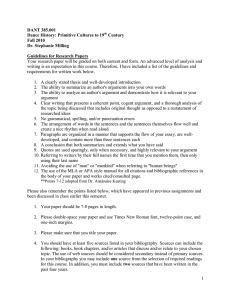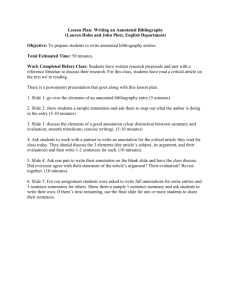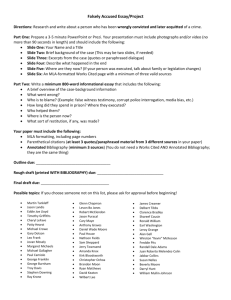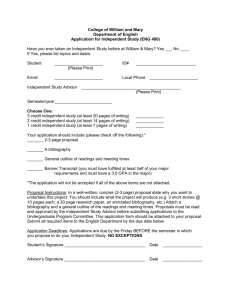DANT 385.001 Dance History: Primitive Cultures through 19 Century
advertisement
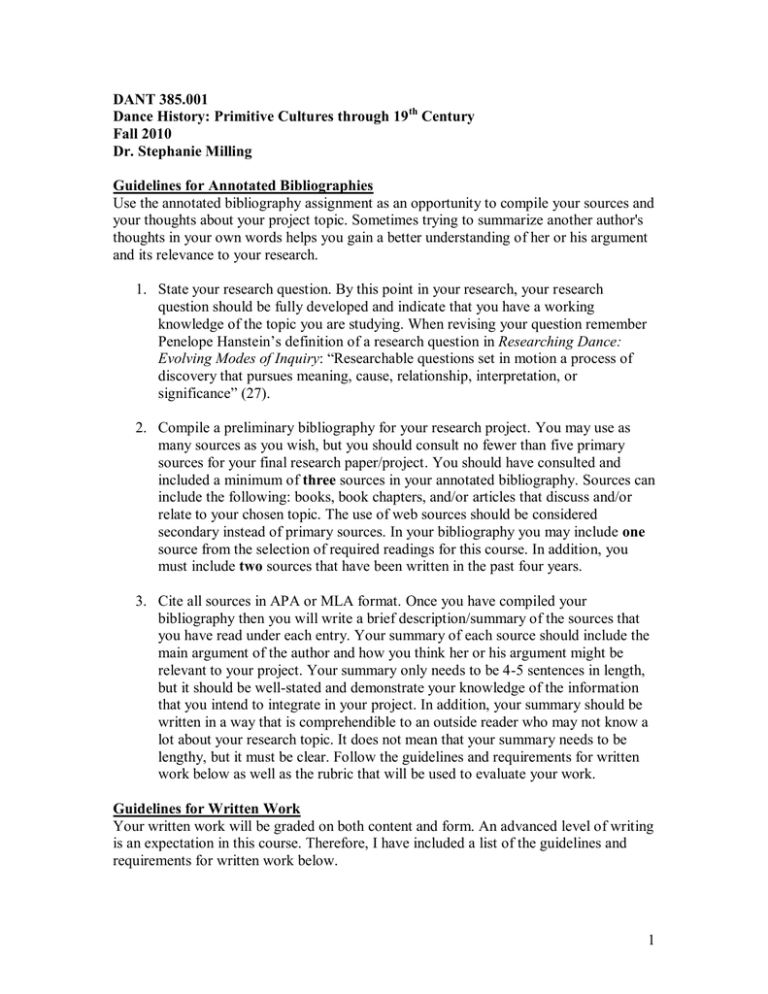
DANT 385.001 Dance History: Primitive Cultures through 19th Century Fall 2010 Dr. Stephanie Milling Guidelines for Annotated Bibliographies Use the annotated bibliography assignment as an opportunity to compile your sources and your thoughts about your project topic. Sometimes trying to summarize another author's thoughts in your own words helps you gain a better understanding of her or his argument and its relevance to your research. 1. State your research question. By this point in your research, your research question should be fully developed and indicate that you have a working knowledge of the topic you are studying. When revising your question remember Penelope Hanstein’s definition of a research question in Researching Dance: Evolving Modes of Inquiry: “Researchable questions set in motion a process of discovery that pursues meaning, cause, relationship, interpretation, or significance” (27). 2. Compile a preliminary bibliography for your research project. You may use as many sources as you wish, but you should consult no fewer than five primary sources for your final research paper/project. You should have consulted and included a minimum of three sources in your annotated bibliography. Sources can include the following: books, book chapters, and/or articles that discuss and/or relate to your chosen topic. The use of web sources should be considered secondary instead of primary sources. In your bibliography you may include one source from the selection of required readings for this course. In addition, you must include two sources that have been written in the past four years. 3. Cite all sources in APA or MLA format. Once you have compiled your bibliography then you will write a brief description/summary of the sources that you have read under each entry. Your summary of each source should include the main argument of the author and how you think her or his argument might be relevant to your project. Your summary only needs to be 4-5 sentences in length, but it should be well-stated and demonstrate your knowledge of the information that you intend to integrate in your project. In addition, your summary should be written in a way that is comprehendible to an outside reader who may not know a lot about your research topic. It does not mean that your summary needs to be lengthy, but it must be clear. Follow the guidelines and requirements for written work below as well as the rubric that will be used to evaluate your work. Guidelines for Written Work Your written work will be graded on both content and form. An advanced level of writing is an expectation in this course. Therefore, I have included a list of the guidelines and requirements for written work below. 1 1. Clear writing that presents a coherent point and cogent argument 2. No grammatical, spelling, and/or punctuation errors 3. The arrangement of words in the sentences and the sentences themselves flow well and create a nice rhythm when read aloud 4. Avoiding the use of "man" or "mankind" when referring to "human beings" **Points 5-7 are borrowed from Dr. AnaLouise Keating Below is a list of the markings that will find on your papers after I have graded them: V or Vague: Vague Reference. Using "This," "It," or other pronouns as the subject of a sentence. For instance: "This is a confusing way to write a sentence." RO: Run-on: Run-on sentences are sentences that actually contain two or more sentences--due to incorrect punctuation. For instance: "The readings were very enjoyable, the majority of the students enjoyed them quite a bit." Here's a really popular run on: "Learning grammar is boring, however, it's important to know how to punctuate properly." Frag: Fragment: Sentence fragment—part of a sentence masquerading as a complete sentence. For instance: "Which meant that the categories were eroding." Awk: Awkward Phrasing: In my experience, awkward phrasing often occurs when writers try to sound like academics—using a lot of prepositional phrases, multi-syllable words, passive sentence construction, etc. Here's an example: "Although problematic, many of the topics covered in this course have much relevance to the complexity of issues investigated, interrogated, and deconstructed in the readings currently under discussion in this course." W.C: Word Choice: I have noticed that writers usually use words that don't quite describe what they are trying to say when they are having trouble varying their words or when they use the thesaurus indiscriminately. Watch out for what I call 'thesaurusitus', a condition when a writer tries to sound really smart by using a big word and her or his sentence ends up making no sense at all. For example, “By scrutinizing the performance through a structure used habitually in the discipline of dance, we understood how depictions of gender, race, class, and ability can limit our own discernment of the world.” Agr: Agreement: The subject and verb of your sentence do not agree in number. For example: "The teacher has an obligation to teach the student how to think critically. When the student learns how to do this, they are more prepared to deal with the issues that they will face in the real world." **This marking system is borrowed from Dr. AnaLouise Keating. The rubric below will be used to evaluate your work. Criteria/Expectations for Assignments 10 possible points 9.8-10 points WOW: Exceeds expectations, guidelines, and requirements for the assignment, amazing ideas which demonstrate thoughtful critical analysis of and reflection upon course material, ideas are organized and articulated in an exceptional manner 2 Strong: Meets the expectations of the assignment, demonstrates insightful critical thinking about course material, ideas are organized and articulated very well Competent: Meets expectations of the assignment, contains good ideas and demonstrates critical thinking skills, but revisions could make this assignment much stronger, the organization and communication of ideas are average Developing: Almost meets the expectations of the assignment, ideas demonstrate some thinking about course material but remain unrefined; organization, and communication of ideas could use many revisions Emerging: Barely meets the expectations of the assignment, ideas demonstrate a minimal amount of reflection upon course material; organization of ideas need major revisions Not Yet: Does not meet any of the guidelines and/or requirements of the assignment, work is sloppy and unintelligible 9-9.7 points 8-8.9 points 7-7.9 points 6-6.9 points 5.9 points and below **This assignment is based upon a similar assignment designed Dr. AnaLouise Keating. 3
